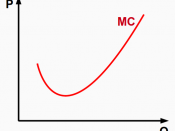Explain the Economic Order Quantity (EOQ) from first principles.
EOQ, or Economic Order Quantity, was developed by F. W. Harris in1913, even if R. H. Wilson is recognized for his early deeply analysis of the model. Harris's original paper was disseminated; it actually was ignored for many years before its rediscovery in 1988. During this period, a lot misunderstanding developed over the origin of the EOQ model.
The model is defined as the optimal quantity of orders that minimizes total variable costs required to order and hold inventory.
The first part of the essay will explain the principles of the EOQ and gives an idea about how it works.
Second part will sets out its advantages and disadvantages.
EOQ is not a simple solution but an instrument, which enable the firm to determine the order size that will reduce the total inventory costs, by calculating an economic order quantity. It refers to the most favourable order volume that will result in the lowest total of order and carrying costs for an article of inventory given its expected usage, carrying costs and ordering cost.
Thus, by dint of its principles, the EOQ tool can be used to form the quantity of inventory that the firm should order each month.
Indeed, there are two categories of costs that need to be considered: ordering costs and carrying costs (also called holding costs) which must be defined.
Holding cost, carrying cost is the cost associated with having inventory on hand. It is made up of the costs linked with the inventory investment and storage cost. For the use of the EOQ calculation, the cost must change based upon the quantity of inventory on hand in order to be included in carrying cost. In the EOQ formula, carrying cost is represented as the annual...


